University Logistics and Supply Chain Management Report on Challenges
VerifiedAdded on 2020/03/04
|15
|3995
|257
Report
AI Summary
This report examines the logistics and supply chain challenges faced by a new international mining company in Australia. It focuses on the transportation of locomotives and coal wagons from Germany to Abbot Point Port, highlighting issues related to safety and security, long distances, and poor road conditions. The report discusses transport modes (sea and road), Australian customs requirements (AQIS), warehouse management, and risk management strategies to mitigate potential problems such as theft, accidents, and fire. Key recommendations include implementing robust security measures, optimizing warehouse operations, and adhering to customs regulations. The analysis covers both Australian and German logistics environments, providing a comprehensive overview of the challenges and potential solutions for ensuring the successful transportation of goods.
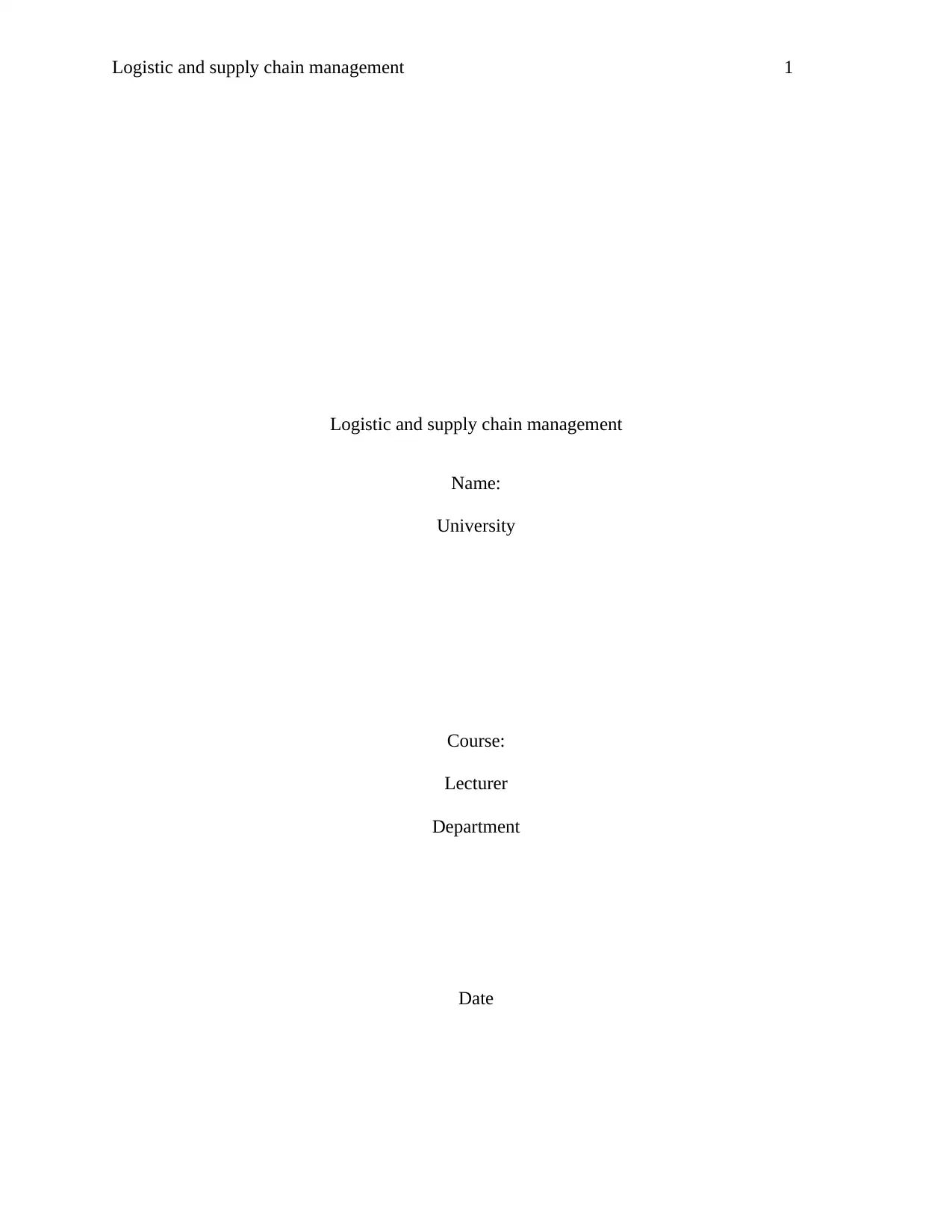
Logistic and supply chain management 1
Logistic and supply chain management
Name:
University
Course:
Lecturer
Department
Date
Logistic and supply chain management
Name:
University
Course:
Lecturer
Department
Date
Paraphrase This Document
Need a fresh take? Get an instant paraphrase of this document with our AI Paraphraser
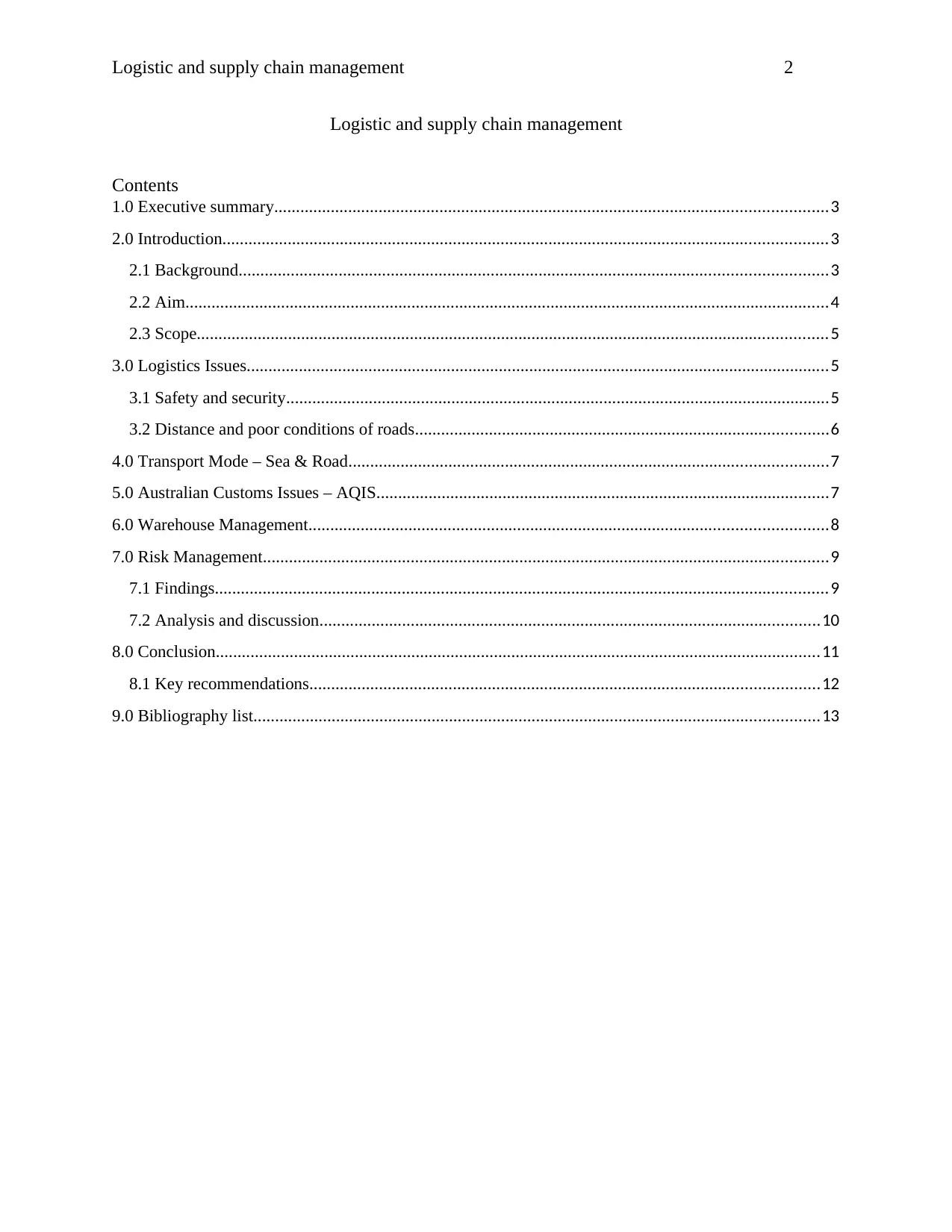
Logistic and supply chain management 2
Logistic and supply chain management
Contents
1.0 Executive summary...............................................................................................................................3
2.0 Introduction...........................................................................................................................................3
2.1 Background.......................................................................................................................................3
2.2 Aim....................................................................................................................................................4
2.3 Scope.................................................................................................................................................5
3.0 Logistics Issues......................................................................................................................................5
3.1 Safety and security.............................................................................................................................5
3.2 Distance and poor conditions of roads...............................................................................................6
4.0 Transport Mode – Sea & Road..............................................................................................................7
5.0 Australian Customs Issues – AQIS........................................................................................................7
6.0 Warehouse Management.......................................................................................................................8
7.0 Risk Management..................................................................................................................................9
7.1 Findings.............................................................................................................................................9
7.2 Analysis and discussion...................................................................................................................10
8.0 Conclusion...........................................................................................................................................11
8.1 Key recommendations.....................................................................................................................12
9.0 Bibliography list..................................................................................................................................13
Logistic and supply chain management
Contents
1.0 Executive summary...............................................................................................................................3
2.0 Introduction...........................................................................................................................................3
2.1 Background.......................................................................................................................................3
2.2 Aim....................................................................................................................................................4
2.3 Scope.................................................................................................................................................5
3.0 Logistics Issues......................................................................................................................................5
3.1 Safety and security.............................................................................................................................5
3.2 Distance and poor conditions of roads...............................................................................................6
4.0 Transport Mode – Sea & Road..............................................................................................................7
5.0 Australian Customs Issues – AQIS........................................................................................................7
6.0 Warehouse Management.......................................................................................................................8
7.0 Risk Management..................................................................................................................................9
7.1 Findings.............................................................................................................................................9
7.2 Analysis and discussion...................................................................................................................10
8.0 Conclusion...........................................................................................................................................11
8.1 Key recommendations.....................................................................................................................12
9.0 Bibliography list..................................................................................................................................13
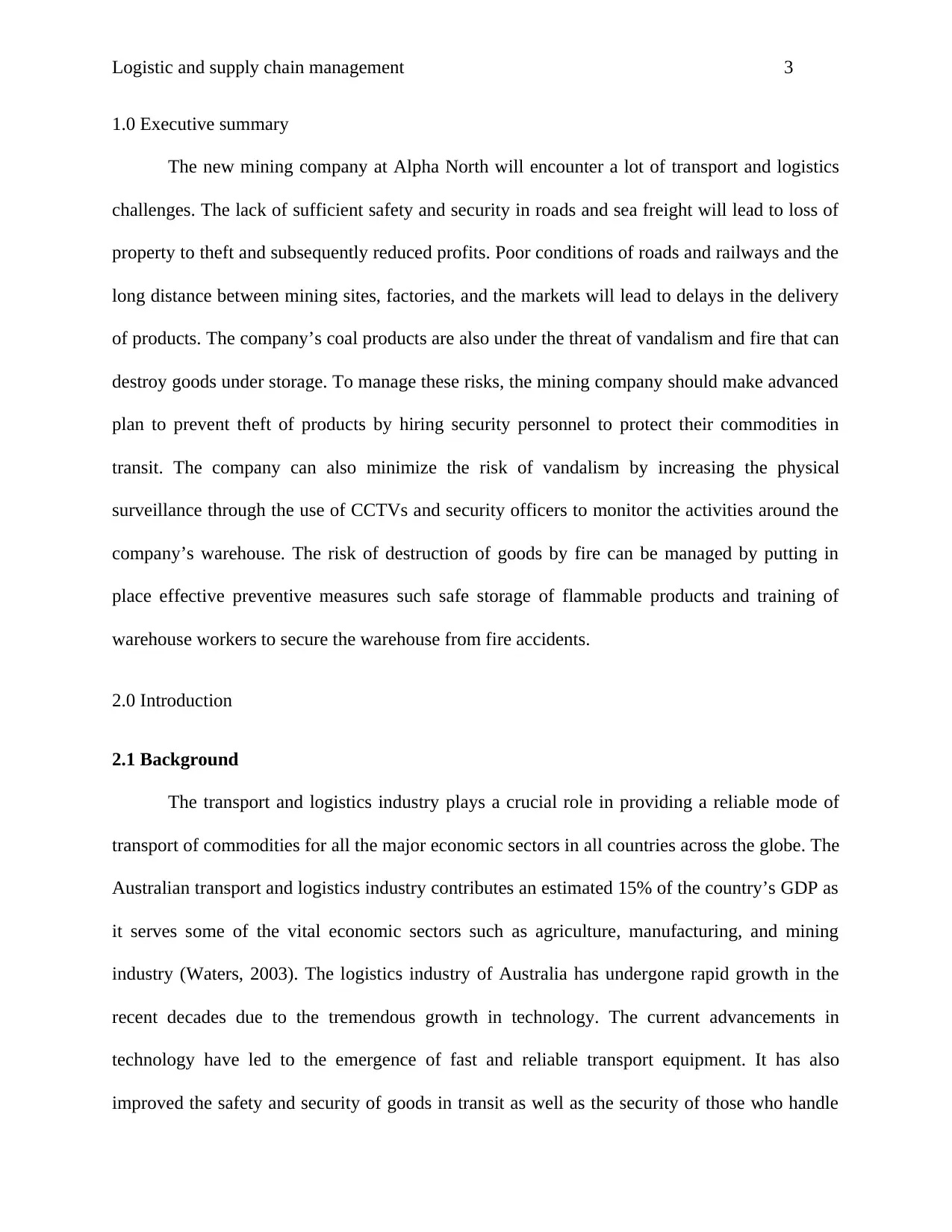
Logistic and supply chain management 3
1.0 Executive summary
The new mining company at Alpha North will encounter a lot of transport and logistics
challenges. The lack of sufficient safety and security in roads and sea freight will lead to loss of
property to theft and subsequently reduced profits. Poor conditions of roads and railways and the
long distance between mining sites, factories, and the markets will lead to delays in the delivery
of products. The company’s coal products are also under the threat of vandalism and fire that can
destroy goods under storage. To manage these risks, the mining company should make advanced
plan to prevent theft of products by hiring security personnel to protect their commodities in
transit. The company can also minimize the risk of vandalism by increasing the physical
surveillance through the use of CCTVs and security officers to monitor the activities around the
company’s warehouse. The risk of destruction of goods by fire can be managed by putting in
place effective preventive measures such safe storage of flammable products and training of
warehouse workers to secure the warehouse from fire accidents.
2.0 Introduction
2.1 Background
The transport and logistics industry plays a crucial role in providing a reliable mode of
transport of commodities for all the major economic sectors in all countries across the globe. The
Australian transport and logistics industry contributes an estimated 15% of the country’s GDP as
it serves some of the vital economic sectors such as agriculture, manufacturing, and mining
industry (Waters, 2003). The logistics industry of Australia has undergone rapid growth in the
recent decades due to the tremendous growth in technology. The current advancements in
technology have led to the emergence of fast and reliable transport equipment. It has also
improved the safety and security of goods in transit as well as the security of those who handle
1.0 Executive summary
The new mining company at Alpha North will encounter a lot of transport and logistics
challenges. The lack of sufficient safety and security in roads and sea freight will lead to loss of
property to theft and subsequently reduced profits. Poor conditions of roads and railways and the
long distance between mining sites, factories, and the markets will lead to delays in the delivery
of products. The company’s coal products are also under the threat of vandalism and fire that can
destroy goods under storage. To manage these risks, the mining company should make advanced
plan to prevent theft of products by hiring security personnel to protect their commodities in
transit. The company can also minimize the risk of vandalism by increasing the physical
surveillance through the use of CCTVs and security officers to monitor the activities around the
company’s warehouse. The risk of destruction of goods by fire can be managed by putting in
place effective preventive measures such safe storage of flammable products and training of
warehouse workers to secure the warehouse from fire accidents.
2.0 Introduction
2.1 Background
The transport and logistics industry plays a crucial role in providing a reliable mode of
transport of commodities for all the major economic sectors in all countries across the globe. The
Australian transport and logistics industry contributes an estimated 15% of the country’s GDP as
it serves some of the vital economic sectors such as agriculture, manufacturing, and mining
industry (Waters, 2003). The logistics industry of Australia has undergone rapid growth in the
recent decades due to the tremendous growth in technology. The current advancements in
technology have led to the emergence of fast and reliable transport equipment. It has also
improved the safety and security of goods in transit as well as the security of those who handle
⊘ This is a preview!⊘
Do you want full access?
Subscribe today to unlock all pages.

Trusted by 1+ million students worldwide
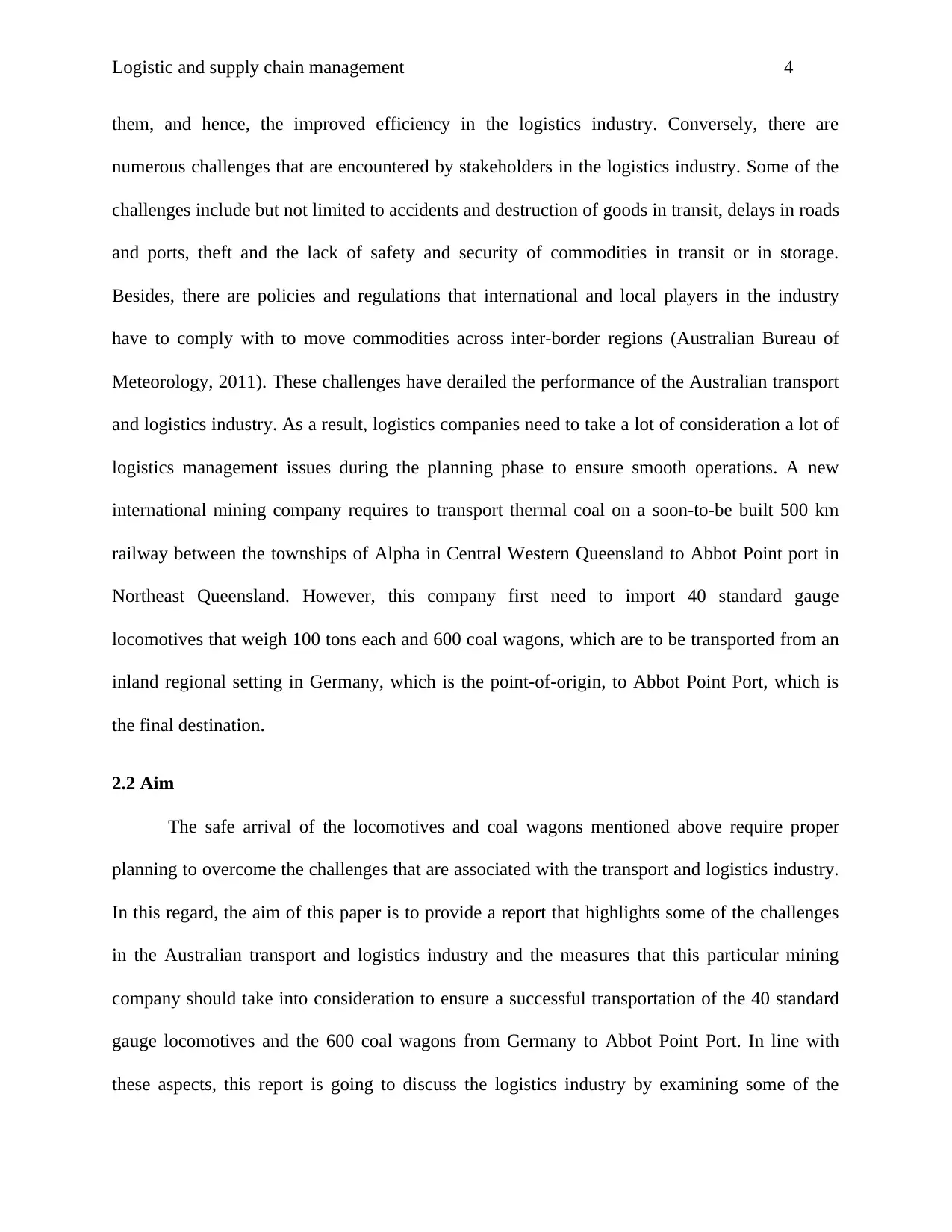
Logistic and supply chain management 4
them, and hence, the improved efficiency in the logistics industry. Conversely, there are
numerous challenges that are encountered by stakeholders in the logistics industry. Some of the
challenges include but not limited to accidents and destruction of goods in transit, delays in roads
and ports, theft and the lack of safety and security of commodities in transit or in storage.
Besides, there are policies and regulations that international and local players in the industry
have to comply with to move commodities across inter-border regions (Australian Bureau of
Meteorology, 2011). These challenges have derailed the performance of the Australian transport
and logistics industry. As a result, logistics companies need to take a lot of consideration a lot of
logistics management issues during the planning phase to ensure smooth operations. A new
international mining company requires to transport thermal coal on a soon-to-be built 500 km
railway between the townships of Alpha in Central Western Queensland to Abbot Point port in
Northeast Queensland. However, this company first need to import 40 standard gauge
locomotives that weigh 100 tons each and 600 coal wagons, which are to be transported from an
inland regional setting in Germany, which is the point-of-origin, to Abbot Point Port, which is
the final destination.
2.2 Aim
The safe arrival of the locomotives and coal wagons mentioned above require proper
planning to overcome the challenges that are associated with the transport and logistics industry.
In this regard, the aim of this paper is to provide a report that highlights some of the challenges
in the Australian transport and logistics industry and the measures that this particular mining
company should take into consideration to ensure a successful transportation of the 40 standard
gauge locomotives and the 600 coal wagons from Germany to Abbot Point Port. In line with
these aspects, this report is going to discuss the logistics industry by examining some of the
them, and hence, the improved efficiency in the logistics industry. Conversely, there are
numerous challenges that are encountered by stakeholders in the logistics industry. Some of the
challenges include but not limited to accidents and destruction of goods in transit, delays in roads
and ports, theft and the lack of safety and security of commodities in transit or in storage.
Besides, there are policies and regulations that international and local players in the industry
have to comply with to move commodities across inter-border regions (Australian Bureau of
Meteorology, 2011). These challenges have derailed the performance of the Australian transport
and logistics industry. As a result, logistics companies need to take a lot of consideration a lot of
logistics management issues during the planning phase to ensure smooth operations. A new
international mining company requires to transport thermal coal on a soon-to-be built 500 km
railway between the townships of Alpha in Central Western Queensland to Abbot Point port in
Northeast Queensland. However, this company first need to import 40 standard gauge
locomotives that weigh 100 tons each and 600 coal wagons, which are to be transported from an
inland regional setting in Germany, which is the point-of-origin, to Abbot Point Port, which is
the final destination.
2.2 Aim
The safe arrival of the locomotives and coal wagons mentioned above require proper
planning to overcome the challenges that are associated with the transport and logistics industry.
In this regard, the aim of this paper is to provide a report that highlights some of the challenges
in the Australian transport and logistics industry and the measures that this particular mining
company should take into consideration to ensure a successful transportation of the 40 standard
gauge locomotives and the 600 coal wagons from Germany to Abbot Point Port. In line with
these aspects, this report is going to discuss the logistics industry by examining some of the
Paraphrase This Document
Need a fresh take? Get an instant paraphrase of this document with our AI Paraphraser
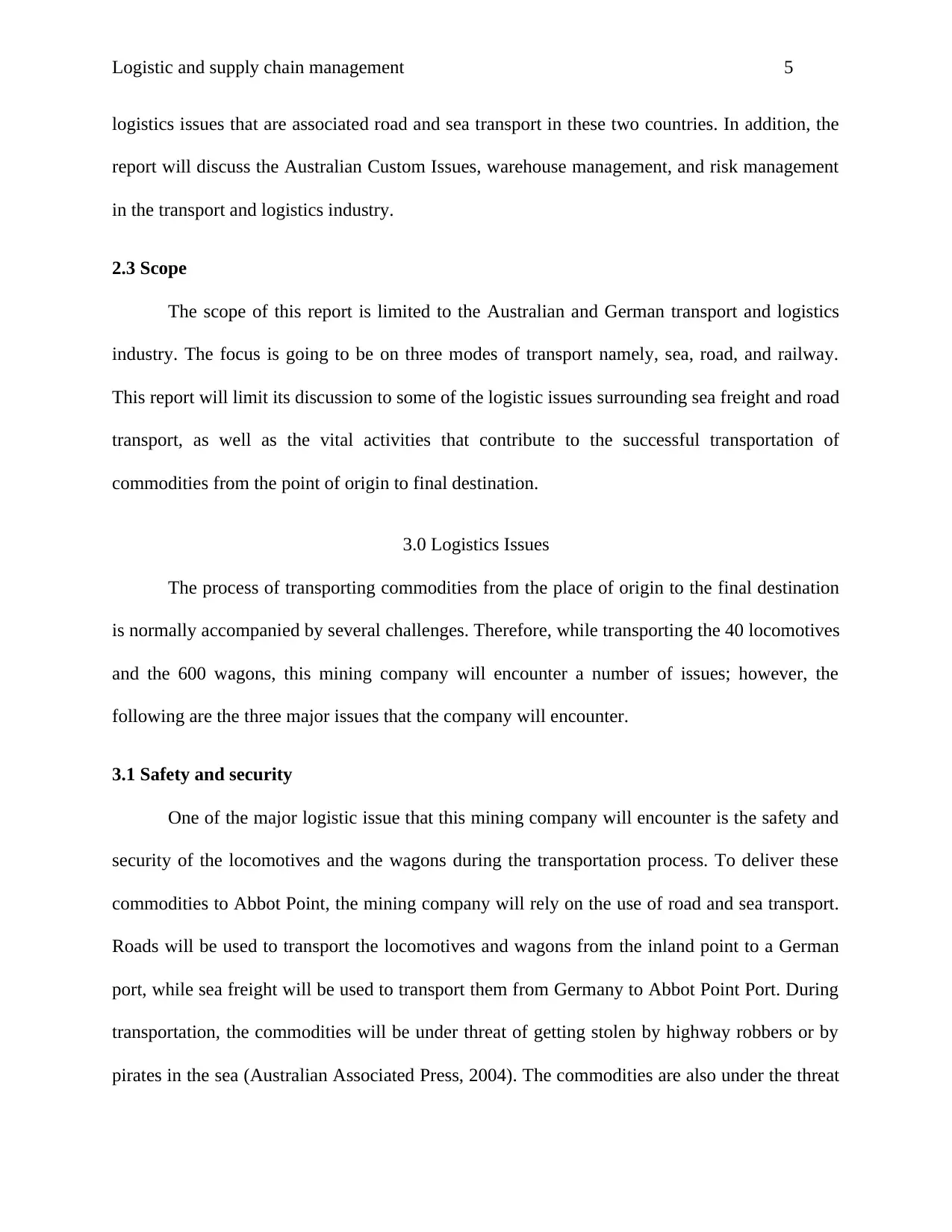
Logistic and supply chain management 5
logistics issues that are associated road and sea transport in these two countries. In addition, the
report will discuss the Australian Custom Issues, warehouse management, and risk management
in the transport and logistics industry.
2.3 Scope
The scope of this report is limited to the Australian and German transport and logistics
industry. The focus is going to be on three modes of transport namely, sea, road, and railway.
This report will limit its discussion to some of the logistic issues surrounding sea freight and road
transport, as well as the vital activities that contribute to the successful transportation of
commodities from the point of origin to final destination.
3.0 Logistics Issues
The process of transporting commodities from the place of origin to the final destination
is normally accompanied by several challenges. Therefore, while transporting the 40 locomotives
and the 600 wagons, this mining company will encounter a number of issues; however, the
following are the three major issues that the company will encounter.
3.1 Safety and security
One of the major logistic issue that this mining company will encounter is the safety and
security of the locomotives and the wagons during the transportation process. To deliver these
commodities to Abbot Point, the mining company will rely on the use of road and sea transport.
Roads will be used to transport the locomotives and wagons from the inland point to a German
port, while sea freight will be used to transport them from Germany to Abbot Point Port. During
transportation, the commodities will be under threat of getting stolen by highway robbers or by
pirates in the sea (Australian Associated Press, 2004). The commodities are also under the threat
logistics issues that are associated road and sea transport in these two countries. In addition, the
report will discuss the Australian Custom Issues, warehouse management, and risk management
in the transport and logistics industry.
2.3 Scope
The scope of this report is limited to the Australian and German transport and logistics
industry. The focus is going to be on three modes of transport namely, sea, road, and railway.
This report will limit its discussion to some of the logistic issues surrounding sea freight and road
transport, as well as the vital activities that contribute to the successful transportation of
commodities from the point of origin to final destination.
3.0 Logistics Issues
The process of transporting commodities from the place of origin to the final destination
is normally accompanied by several challenges. Therefore, while transporting the 40 locomotives
and the 600 wagons, this mining company will encounter a number of issues; however, the
following are the three major issues that the company will encounter.
3.1 Safety and security
One of the major logistic issue that this mining company will encounter is the safety and
security of the locomotives and the wagons during the transportation process. To deliver these
commodities to Abbot Point, the mining company will rely on the use of road and sea transport.
Roads will be used to transport the locomotives and wagons from the inland point to a German
port, while sea freight will be used to transport them from Germany to Abbot Point Port. During
transportation, the commodities will be under threat of getting stolen by highway robbers or by
pirates in the sea (Australian Associated Press, 2004). The commodities are also under the threat
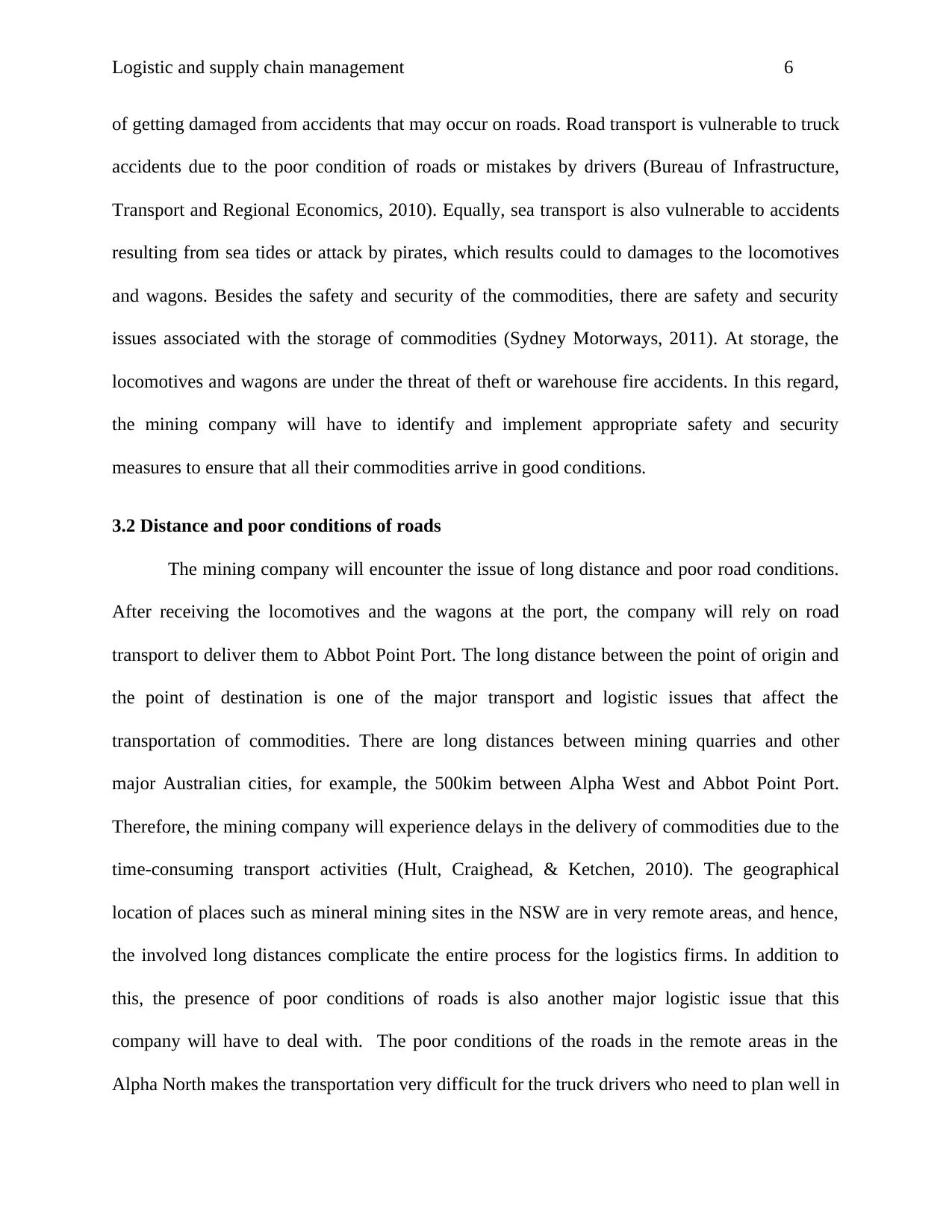
Logistic and supply chain management 6
of getting damaged from accidents that may occur on roads. Road transport is vulnerable to truck
accidents due to the poor condition of roads or mistakes by drivers (Bureau of Infrastructure,
Transport and Regional Economics, 2010). Equally, sea transport is also vulnerable to accidents
resulting from sea tides or attack by pirates, which results could to damages to the locomotives
and wagons. Besides the safety and security of the commodities, there are safety and security
issues associated with the storage of commodities (Sydney Motorways, 2011). At storage, the
locomotives and wagons are under the threat of theft or warehouse fire accidents. In this regard,
the mining company will have to identify and implement appropriate safety and security
measures to ensure that all their commodities arrive in good conditions.
3.2 Distance and poor conditions of roads
The mining company will encounter the issue of long distance and poor road conditions.
After receiving the locomotives and the wagons at the port, the company will rely on road
transport to deliver them to Abbot Point Port. The long distance between the point of origin and
the point of destination is one of the major transport and logistic issues that affect the
transportation of commodities. There are long distances between mining quarries and other
major Australian cities, for example, the 500kim between Alpha West and Abbot Point Port.
Therefore, the mining company will experience delays in the delivery of commodities due to the
time-consuming transport activities (Hult, Craighead, & Ketchen, 2010). The geographical
location of places such as mineral mining sites in the NSW are in very remote areas, and hence,
the involved long distances complicate the entire process for the logistics firms. In addition to
this, the presence of poor conditions of roads is also another major logistic issue that this
company will have to deal with. The poor conditions of the roads in the remote areas in the
Alpha North makes the transportation very difficult for the truck drivers who need to plan well in
of getting damaged from accidents that may occur on roads. Road transport is vulnerable to truck
accidents due to the poor condition of roads or mistakes by drivers (Bureau of Infrastructure,
Transport and Regional Economics, 2010). Equally, sea transport is also vulnerable to accidents
resulting from sea tides or attack by pirates, which results could to damages to the locomotives
and wagons. Besides the safety and security of the commodities, there are safety and security
issues associated with the storage of commodities (Sydney Motorways, 2011). At storage, the
locomotives and wagons are under the threat of theft or warehouse fire accidents. In this regard,
the mining company will have to identify and implement appropriate safety and security
measures to ensure that all their commodities arrive in good conditions.
3.2 Distance and poor conditions of roads
The mining company will encounter the issue of long distance and poor road conditions.
After receiving the locomotives and the wagons at the port, the company will rely on road
transport to deliver them to Abbot Point Port. The long distance between the point of origin and
the point of destination is one of the major transport and logistic issues that affect the
transportation of commodities. There are long distances between mining quarries and other
major Australian cities, for example, the 500kim between Alpha West and Abbot Point Port.
Therefore, the mining company will experience delays in the delivery of commodities due to the
time-consuming transport activities (Hult, Craighead, & Ketchen, 2010). The geographical
location of places such as mineral mining sites in the NSW are in very remote areas, and hence,
the involved long distances complicate the entire process for the logistics firms. In addition to
this, the presence of poor conditions of roads is also another major logistic issue that this
company will have to deal with. The poor conditions of the roads in the remote areas in the
Alpha North makes the transportation very difficult for the truck drivers who need to plan well in
⊘ This is a preview!⊘
Do you want full access?
Subscribe today to unlock all pages.

Trusted by 1+ million students worldwide
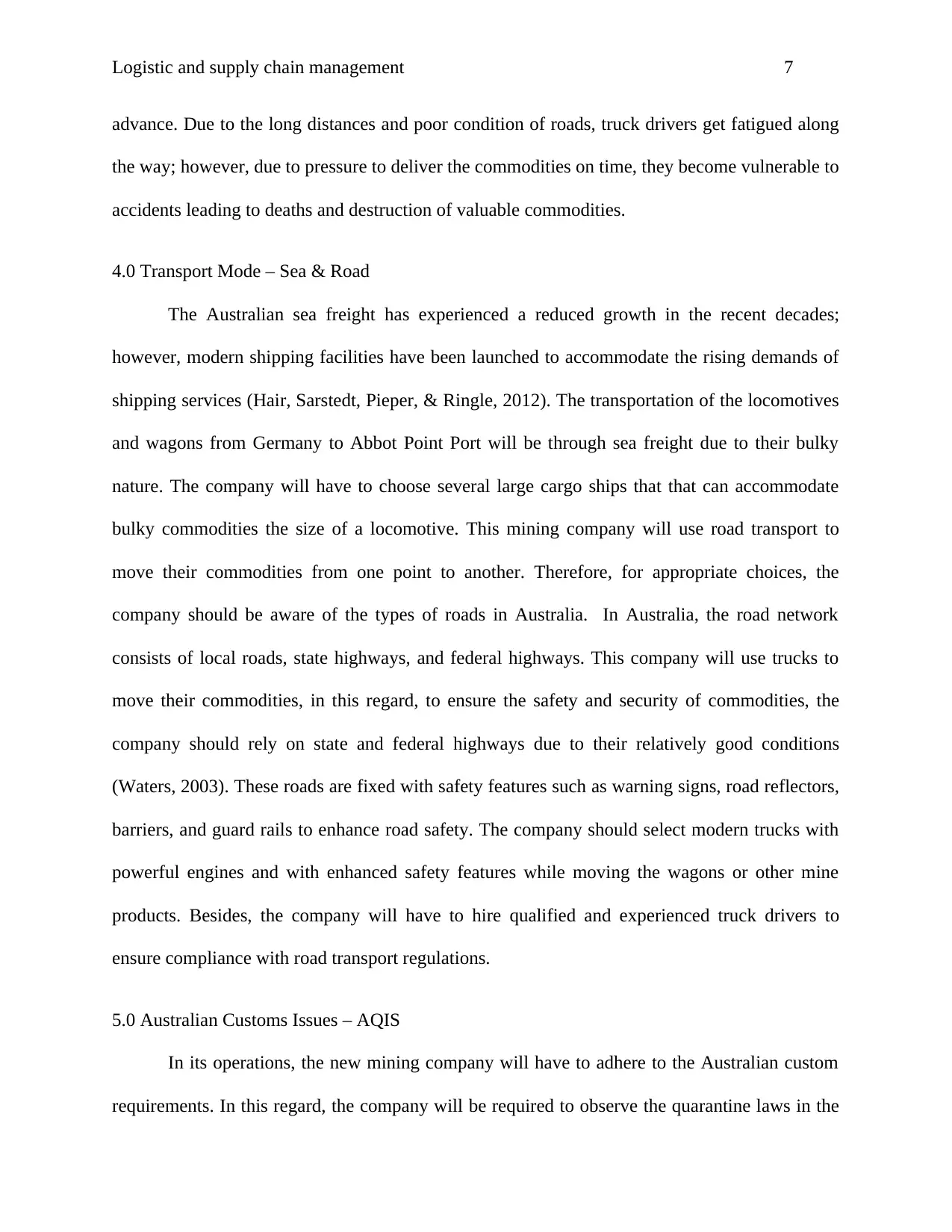
Logistic and supply chain management 7
advance. Due to the long distances and poor condition of roads, truck drivers get fatigued along
the way; however, due to pressure to deliver the commodities on time, they become vulnerable to
accidents leading to deaths and destruction of valuable commodities.
4.0 Transport Mode – Sea & Road
The Australian sea freight has experienced a reduced growth in the recent decades;
however, modern shipping facilities have been launched to accommodate the rising demands of
shipping services (Hair, Sarstedt, Pieper, & Ringle, 2012). The transportation of the locomotives
and wagons from Germany to Abbot Point Port will be through sea freight due to their bulky
nature. The company will have to choose several large cargo ships that that can accommodate
bulky commodities the size of a locomotive. This mining company will use road transport to
move their commodities from one point to another. Therefore, for appropriate choices, the
company should be aware of the types of roads in Australia. In Australia, the road network
consists of local roads, state highways, and federal highways. This company will use trucks to
move their commodities, in this regard, to ensure the safety and security of commodities, the
company should rely on state and federal highways due to their relatively good conditions
(Waters, 2003). These roads are fixed with safety features such as warning signs, road reflectors,
barriers, and guard rails to enhance road safety. The company should select modern trucks with
powerful engines and with enhanced safety features while moving the wagons or other mine
products. Besides, the company will have to hire qualified and experienced truck drivers to
ensure compliance with road transport regulations.
5.0 Australian Customs Issues – AQIS
In its operations, the new mining company will have to adhere to the Australian custom
requirements. In this regard, the company will be required to observe the quarantine laws in the
advance. Due to the long distances and poor condition of roads, truck drivers get fatigued along
the way; however, due to pressure to deliver the commodities on time, they become vulnerable to
accidents leading to deaths and destruction of valuable commodities.
4.0 Transport Mode – Sea & Road
The Australian sea freight has experienced a reduced growth in the recent decades;
however, modern shipping facilities have been launched to accommodate the rising demands of
shipping services (Hair, Sarstedt, Pieper, & Ringle, 2012). The transportation of the locomotives
and wagons from Germany to Abbot Point Port will be through sea freight due to their bulky
nature. The company will have to choose several large cargo ships that that can accommodate
bulky commodities the size of a locomotive. This mining company will use road transport to
move their commodities from one point to another. Therefore, for appropriate choices, the
company should be aware of the types of roads in Australia. In Australia, the road network
consists of local roads, state highways, and federal highways. This company will use trucks to
move their commodities, in this regard, to ensure the safety and security of commodities, the
company should rely on state and federal highways due to their relatively good conditions
(Waters, 2003). These roads are fixed with safety features such as warning signs, road reflectors,
barriers, and guard rails to enhance road safety. The company should select modern trucks with
powerful engines and with enhanced safety features while moving the wagons or other mine
products. Besides, the company will have to hire qualified and experienced truck drivers to
ensure compliance with road transport regulations.
5.0 Australian Customs Issues – AQIS
In its operations, the new mining company will have to adhere to the Australian custom
requirements. In this regard, the company will be required to observe the quarantine laws in the
Paraphrase This Document
Need a fresh take? Get an instant paraphrase of this document with our AI Paraphraser
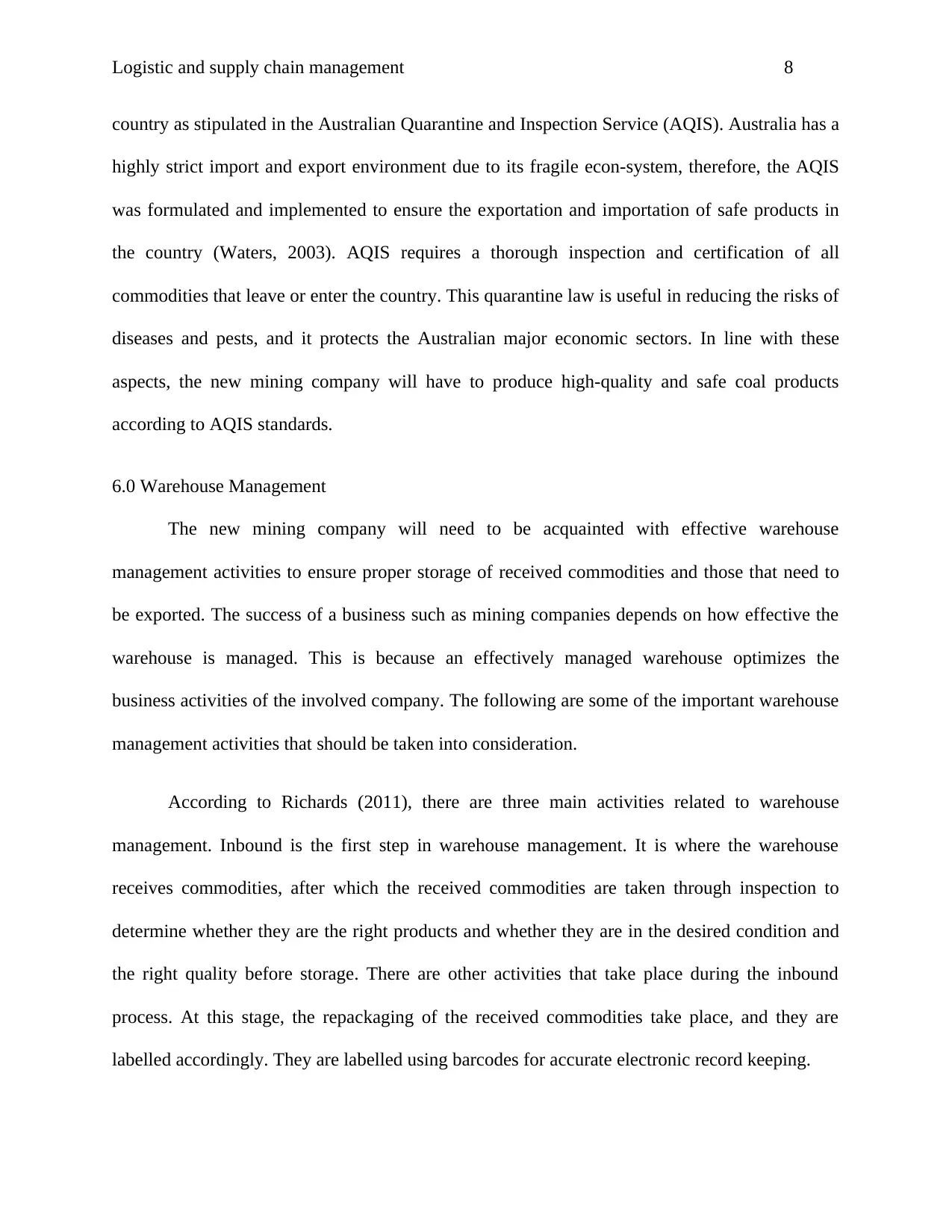
Logistic and supply chain management 8
country as stipulated in the Australian Quarantine and Inspection Service (AQIS). Australia has a
highly strict import and export environment due to its fragile econ-system, therefore, the AQIS
was formulated and implemented to ensure the exportation and importation of safe products in
the country (Waters, 2003). AQIS requires a thorough inspection and certification of all
commodities that leave or enter the country. This quarantine law is useful in reducing the risks of
diseases and pests, and it protects the Australian major economic sectors. In line with these
aspects, the new mining company will have to produce high-quality and safe coal products
according to AQIS standards.
6.0 Warehouse Management
The new mining company will need to be acquainted with effective warehouse
management activities to ensure proper storage of received commodities and those that need to
be exported. The success of a business such as mining companies depends on how effective the
warehouse is managed. This is because an effectively managed warehouse optimizes the
business activities of the involved company. The following are some of the important warehouse
management activities that should be taken into consideration.
According to Richards (2011), there are three main activities related to warehouse
management. Inbound is the first step in warehouse management. It is where the warehouse
receives commodities, after which the received commodities are taken through inspection to
determine whether they are the right products and whether they are in the desired condition and
the right quality before storage. There are other activities that take place during the inbound
process. At this stage, the repackaging of the received commodities take place, and they are
labelled accordingly. They are labelled using barcodes for accurate electronic record keeping.
country as stipulated in the Australian Quarantine and Inspection Service (AQIS). Australia has a
highly strict import and export environment due to its fragile econ-system, therefore, the AQIS
was formulated and implemented to ensure the exportation and importation of safe products in
the country (Waters, 2003). AQIS requires a thorough inspection and certification of all
commodities that leave or enter the country. This quarantine law is useful in reducing the risks of
diseases and pests, and it protects the Australian major economic sectors. In line with these
aspects, the new mining company will have to produce high-quality and safe coal products
according to AQIS standards.
6.0 Warehouse Management
The new mining company will need to be acquainted with effective warehouse
management activities to ensure proper storage of received commodities and those that need to
be exported. The success of a business such as mining companies depends on how effective the
warehouse is managed. This is because an effectively managed warehouse optimizes the
business activities of the involved company. The following are some of the important warehouse
management activities that should be taken into consideration.
According to Richards (2011), there are three main activities related to warehouse
management. Inbound is the first step in warehouse management. It is where the warehouse
receives commodities, after which the received commodities are taken through inspection to
determine whether they are the right products and whether they are in the desired condition and
the right quality before storage. There are other activities that take place during the inbound
process. At this stage, the repackaging of the received commodities take place, and they are
labelled accordingly. They are labelled using barcodes for accurate electronic record keeping.
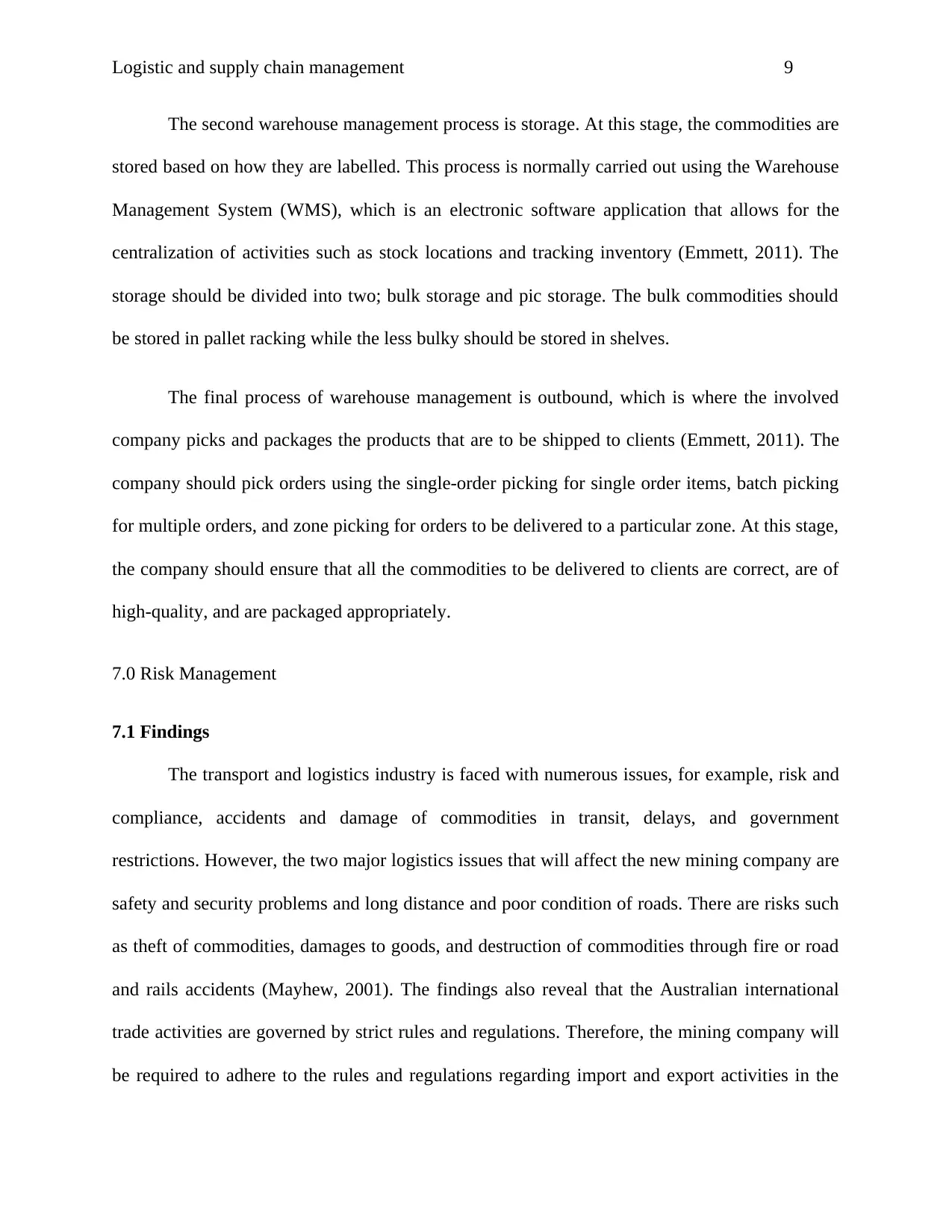
Logistic and supply chain management 9
The second warehouse management process is storage. At this stage, the commodities are
stored based on how they are labelled. This process is normally carried out using the Warehouse
Management System (WMS), which is an electronic software application that allows for the
centralization of activities such as stock locations and tracking inventory (Emmett, 2011). The
storage should be divided into two; bulk storage and pic storage. The bulk commodities should
be stored in pallet racking while the less bulky should be stored in shelves.
The final process of warehouse management is outbound, which is where the involved
company picks and packages the products that are to be shipped to clients (Emmett, 2011). The
company should pick orders using the single-order picking for single order items, batch picking
for multiple orders, and zone picking for orders to be delivered to a particular zone. At this stage,
the company should ensure that all the commodities to be delivered to clients are correct, are of
high-quality, and are packaged appropriately.
7.0 Risk Management
7.1 Findings
The transport and logistics industry is faced with numerous issues, for example, risk and
compliance, accidents and damage of commodities in transit, delays, and government
restrictions. However, the two major logistics issues that will affect the new mining company are
safety and security problems and long distance and poor condition of roads. There are risks such
as theft of commodities, damages to goods, and destruction of commodities through fire or road
and rails accidents (Mayhew, 2001). The findings also reveal that the Australian international
trade activities are governed by strict rules and regulations. Therefore, the mining company will
be required to adhere to the rules and regulations regarding import and export activities in the
The second warehouse management process is storage. At this stage, the commodities are
stored based on how they are labelled. This process is normally carried out using the Warehouse
Management System (WMS), which is an electronic software application that allows for the
centralization of activities such as stock locations and tracking inventory (Emmett, 2011). The
storage should be divided into two; bulk storage and pic storage. The bulk commodities should
be stored in pallet racking while the less bulky should be stored in shelves.
The final process of warehouse management is outbound, which is where the involved
company picks and packages the products that are to be shipped to clients (Emmett, 2011). The
company should pick orders using the single-order picking for single order items, batch picking
for multiple orders, and zone picking for orders to be delivered to a particular zone. At this stage,
the company should ensure that all the commodities to be delivered to clients are correct, are of
high-quality, and are packaged appropriately.
7.0 Risk Management
7.1 Findings
The transport and logistics industry is faced with numerous issues, for example, risk and
compliance, accidents and damage of commodities in transit, delays, and government
restrictions. However, the two major logistics issues that will affect the new mining company are
safety and security problems and long distance and poor condition of roads. There are risks such
as theft of commodities, damages to goods, and destruction of commodities through fire or road
and rails accidents (Mayhew, 2001). The findings also reveal that the Australian international
trade activities are governed by strict rules and regulations. Therefore, the mining company will
be required to adhere to the rules and regulations regarding import and export activities in the
⊘ This is a preview!⊘
Do you want full access?
Subscribe today to unlock all pages.

Trusted by 1+ million students worldwide
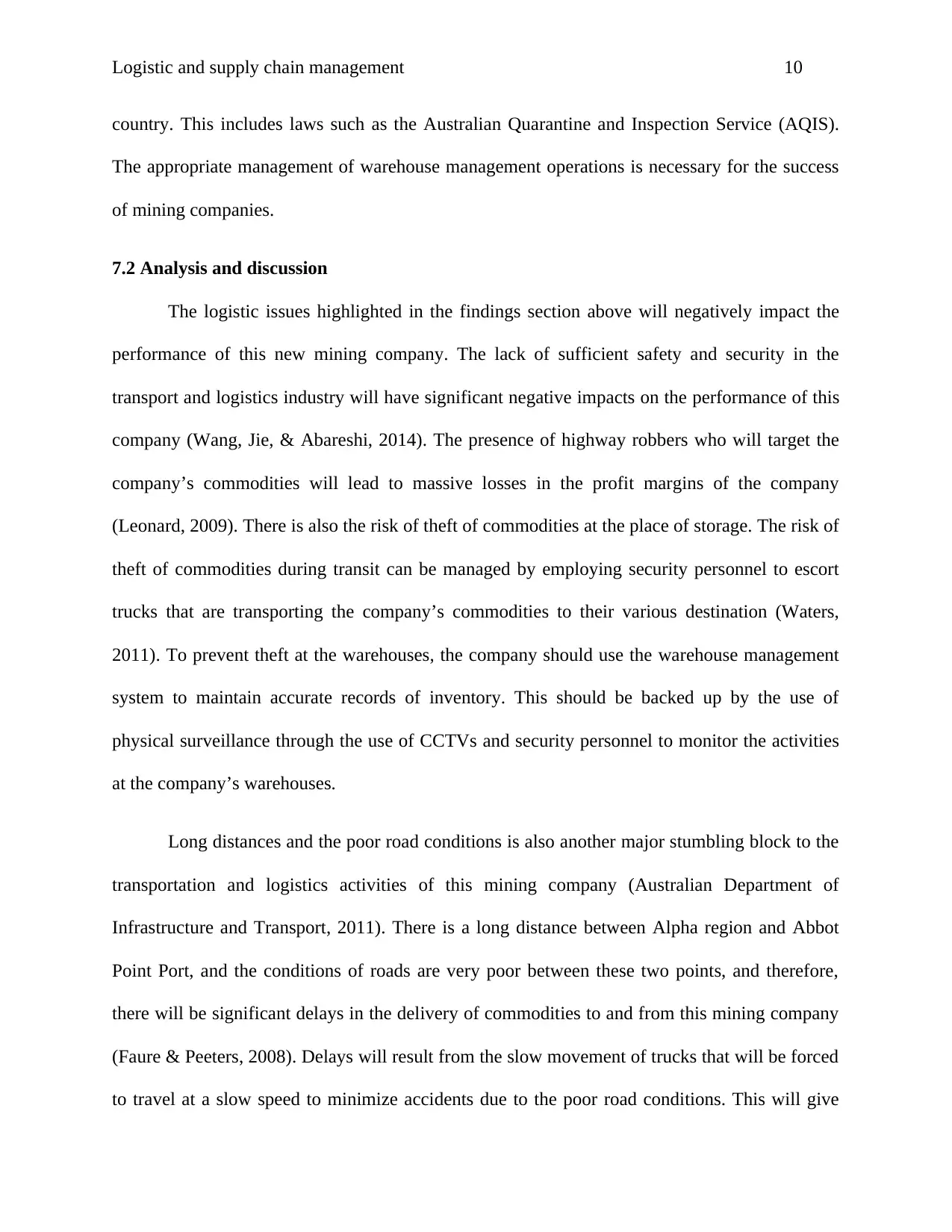
Logistic and supply chain management 10
country. This includes laws such as the Australian Quarantine and Inspection Service (AQIS).
The appropriate management of warehouse management operations is necessary for the success
of mining companies.
7.2 Analysis and discussion
The logistic issues highlighted in the findings section above will negatively impact the
performance of this new mining company. The lack of sufficient safety and security in the
transport and logistics industry will have significant negative impacts on the performance of this
company (Wang, Jie, & Abareshi, 2014). The presence of highway robbers who will target the
company’s commodities will lead to massive losses in the profit margins of the company
(Leonard, 2009). There is also the risk of theft of commodities at the place of storage. The risk of
theft of commodities during transit can be managed by employing security personnel to escort
trucks that are transporting the company’s commodities to their various destination (Waters,
2011). To prevent theft at the warehouses, the company should use the warehouse management
system to maintain accurate records of inventory. This should be backed up by the use of
physical surveillance through the use of CCTVs and security personnel to monitor the activities
at the company’s warehouses.
Long distances and the poor road conditions is also another major stumbling block to the
transportation and logistics activities of this mining company (Australian Department of
Infrastructure and Transport, 2011). There is a long distance between Alpha region and Abbot
Point Port, and the conditions of roads are very poor between these two points, and therefore,
there will be significant delays in the delivery of commodities to and from this mining company
(Faure & Peeters, 2008). Delays will result from the slow movement of trucks that will be forced
to travel at a slow speed to minimize accidents due to the poor road conditions. This will give
country. This includes laws such as the Australian Quarantine and Inspection Service (AQIS).
The appropriate management of warehouse management operations is necessary for the success
of mining companies.
7.2 Analysis and discussion
The logistic issues highlighted in the findings section above will negatively impact the
performance of this new mining company. The lack of sufficient safety and security in the
transport and logistics industry will have significant negative impacts on the performance of this
company (Wang, Jie, & Abareshi, 2014). The presence of highway robbers who will target the
company’s commodities will lead to massive losses in the profit margins of the company
(Leonard, 2009). There is also the risk of theft of commodities at the place of storage. The risk of
theft of commodities during transit can be managed by employing security personnel to escort
trucks that are transporting the company’s commodities to their various destination (Waters,
2011). To prevent theft at the warehouses, the company should use the warehouse management
system to maintain accurate records of inventory. This should be backed up by the use of
physical surveillance through the use of CCTVs and security personnel to monitor the activities
at the company’s warehouses.
Long distances and the poor road conditions is also another major stumbling block to the
transportation and logistics activities of this mining company (Australian Department of
Infrastructure and Transport, 2011). There is a long distance between Alpha region and Abbot
Point Port, and the conditions of roads are very poor between these two points, and therefore,
there will be significant delays in the delivery of commodities to and from this mining company
(Faure & Peeters, 2008). Delays will result from the slow movement of trucks that will be forced
to travel at a slow speed to minimize accidents due to the poor road conditions. This will give
Paraphrase This Document
Need a fresh take? Get an instant paraphrase of this document with our AI Paraphraser
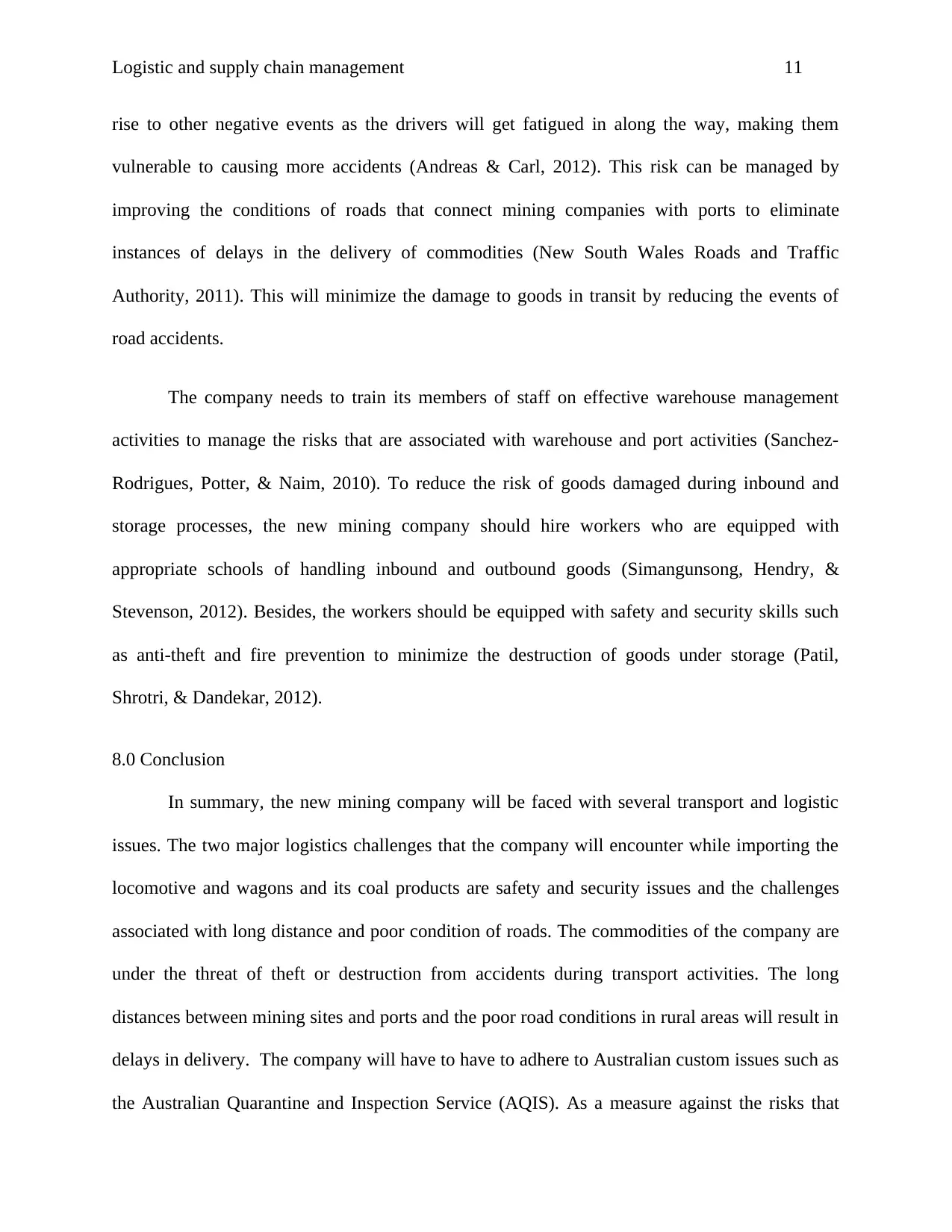
Logistic and supply chain management 11
rise to other negative events as the drivers will get fatigued in along the way, making them
vulnerable to causing more accidents (Andreas & Carl, 2012). This risk can be managed by
improving the conditions of roads that connect mining companies with ports to eliminate
instances of delays in the delivery of commodities (New South Wales Roads and Traffic
Authority, 2011). This will minimize the damage to goods in transit by reducing the events of
road accidents.
The company needs to train its members of staff on effective warehouse management
activities to manage the risks that are associated with warehouse and port activities (Sanchez-
Rodrigues, Potter, & Naim, 2010). To reduce the risk of goods damaged during inbound and
storage processes, the new mining company should hire workers who are equipped with
appropriate schools of handling inbound and outbound goods (Simangunsong, Hendry, &
Stevenson, 2012). Besides, the workers should be equipped with safety and security skills such
as anti-theft and fire prevention to minimize the destruction of goods under storage (Patil,
Shrotri, & Dandekar, 2012).
8.0 Conclusion
In summary, the new mining company will be faced with several transport and logistic
issues. The two major logistics challenges that the company will encounter while importing the
locomotive and wagons and its coal products are safety and security issues and the challenges
associated with long distance and poor condition of roads. The commodities of the company are
under the threat of theft or destruction from accidents during transport activities. The long
distances between mining sites and ports and the poor road conditions in rural areas will result in
delays in delivery. The company will have to have to adhere to Australian custom issues such as
the Australian Quarantine and Inspection Service (AQIS). As a measure against the risks that
rise to other negative events as the drivers will get fatigued in along the way, making them
vulnerable to causing more accidents (Andreas & Carl, 2012). This risk can be managed by
improving the conditions of roads that connect mining companies with ports to eliminate
instances of delays in the delivery of commodities (New South Wales Roads and Traffic
Authority, 2011). This will minimize the damage to goods in transit by reducing the events of
road accidents.
The company needs to train its members of staff on effective warehouse management
activities to manage the risks that are associated with warehouse and port activities (Sanchez-
Rodrigues, Potter, & Naim, 2010). To reduce the risk of goods damaged during inbound and
storage processes, the new mining company should hire workers who are equipped with
appropriate schools of handling inbound and outbound goods (Simangunsong, Hendry, &
Stevenson, 2012). Besides, the workers should be equipped with safety and security skills such
as anti-theft and fire prevention to minimize the destruction of goods under storage (Patil,
Shrotri, & Dandekar, 2012).
8.0 Conclusion
In summary, the new mining company will be faced with several transport and logistic
issues. The two major logistics challenges that the company will encounter while importing the
locomotive and wagons and its coal products are safety and security issues and the challenges
associated with long distance and poor condition of roads. The commodities of the company are
under the threat of theft or destruction from accidents during transport activities. The long
distances between mining sites and ports and the poor road conditions in rural areas will result in
delays in delivery. The company will have to have to adhere to Australian custom issues such as
the Australian Quarantine and Inspection Service (AQIS). As a measure against the risks that
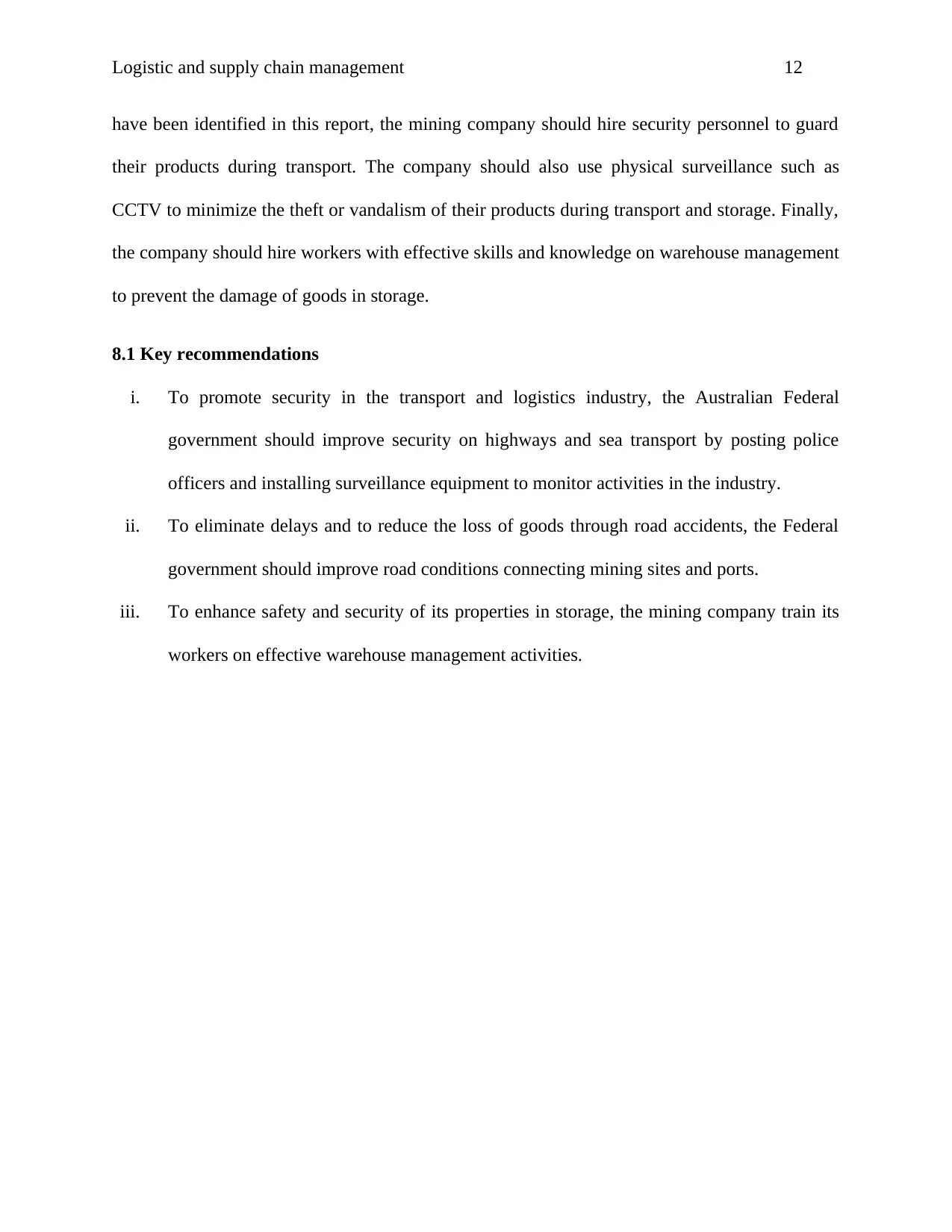
Logistic and supply chain management 12
have been identified in this report, the mining company should hire security personnel to guard
their products during transport. The company should also use physical surveillance such as
CCTV to minimize the theft or vandalism of their products during transport and storage. Finally,
the company should hire workers with effective skills and knowledge on warehouse management
to prevent the damage of goods in storage.
8.1 Key recommendations
i. To promote security in the transport and logistics industry, the Australian Federal
government should improve security on highways and sea transport by posting police
officers and installing surveillance equipment to monitor activities in the industry.
ii. To eliminate delays and to reduce the loss of goods through road accidents, the Federal
government should improve road conditions connecting mining sites and ports.
iii. To enhance safety and security of its properties in storage, the mining company train its
workers on effective warehouse management activities.
have been identified in this report, the mining company should hire security personnel to guard
their products during transport. The company should also use physical surveillance such as
CCTV to minimize the theft or vandalism of their products during transport and storage. Finally,
the company should hire workers with effective skills and knowledge on warehouse management
to prevent the damage of goods in storage.
8.1 Key recommendations
i. To promote security in the transport and logistics industry, the Australian Federal
government should improve security on highways and sea transport by posting police
officers and installing surveillance equipment to monitor activities in the industry.
ii. To eliminate delays and to reduce the loss of goods through road accidents, the Federal
government should improve road conditions connecting mining sites and ports.
iii. To enhance safety and security of its properties in storage, the mining company train its
workers on effective warehouse management activities.
⊘ This is a preview!⊘
Do you want full access?
Subscribe today to unlock all pages.

Trusted by 1+ million students worldwide
1 out of 15
Related Documents
Your All-in-One AI-Powered Toolkit for Academic Success.
+13062052269
info@desklib.com
Available 24*7 on WhatsApp / Email
![[object Object]](/_next/static/media/star-bottom.7253800d.svg)
Unlock your academic potential
Copyright © 2020–2025 A2Z Services. All Rights Reserved. Developed and managed by ZUCOL.





